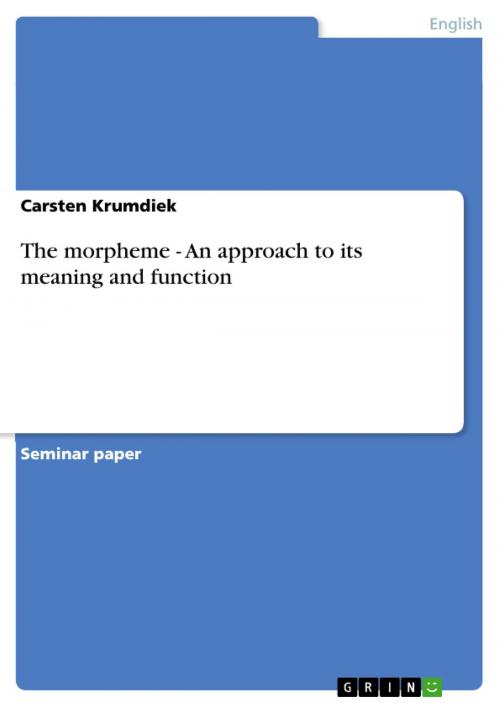The morpheme - An approach to its meaning and function
An approach to its meaning and function
Nonfiction, Entertainment, Drama, Anthologies| Author: | Carsten Krumdiek | ISBN: | 9783638628518 |
| Publisher: | GRIN Publishing | Publication: | April 4, 2007 |
| Imprint: | GRIN Publishing | Language: | English |
| Author: | Carsten Krumdiek |
| ISBN: | 9783638628518 |
| Publisher: | GRIN Publishing |
| Publication: | April 4, 2007 |
| Imprint: | GRIN Publishing |
| Language: | English |
Seminar paper from the year 2004 in the subject English Language and Literature Studies - Linguistics, grade: 2,0, University of Cologne (Englisches Seminar), course: English Morphology, 12 entries in the bibliography, language: English, abstract: When studying linguistics, students are confronted with a high degree of terminology right on from the beginning of their studies. One might assume that understanding it should not really be a problem if one considers a standard dictionary or inquires other scholars in order to find an answer to one's lack of knowledge. However, in some cases it is simply not that easy. In the following we will take a look at the notion of the morpheme. The problem is that several different definitions exist and scholars have to be 100% aware of the meaning when confronted with linguistic literature. The Oxford Concise English Dictionary (OCED) claims the morpheme to be: 'A meaningful morphological unit of a language that cannot be further divided' (OCED 1999:926) But is this a sufficient definition of the term? Are morphemes really always meaningful units? In order to understand the different opinions scholars have when referring to the morpheme, one has to have a good look at their different point of views of the field of morphology. Some scholars consider a morpheme-based approach to be the correct way of dealing with morphemes, in which they either emphasize meaning or grammatical function of morphemes, whereas others rather identify themselves with the word-form based approach, by which they entirely reject the significance of morphemes for the meaning of the sign, while concentrating on word-forms. In the following we will take a closer look at several definitions of themorpheme,established by scholars of different diachronical environments in order to find a solution to this problem and a more or less concrete definition. In the second part, the importance of the morpheme with reference to the concept of allomorphy will be examined to understand how they function and how they are realized.
Seminar paper from the year 2004 in the subject English Language and Literature Studies - Linguistics, grade: 2,0, University of Cologne (Englisches Seminar), course: English Morphology, 12 entries in the bibliography, language: English, abstract: When studying linguistics, students are confronted with a high degree of terminology right on from the beginning of their studies. One might assume that understanding it should not really be a problem if one considers a standard dictionary or inquires other scholars in order to find an answer to one's lack of knowledge. However, in some cases it is simply not that easy. In the following we will take a look at the notion of the morpheme. The problem is that several different definitions exist and scholars have to be 100% aware of the meaning when confronted with linguistic literature. The Oxford Concise English Dictionary (OCED) claims the morpheme to be: 'A meaningful morphological unit of a language that cannot be further divided' (OCED 1999:926) But is this a sufficient definition of the term? Are morphemes really always meaningful units? In order to understand the different opinions scholars have when referring to the morpheme, one has to have a good look at their different point of views of the field of morphology. Some scholars consider a morpheme-based approach to be the correct way of dealing with morphemes, in which they either emphasize meaning or grammatical function of morphemes, whereas others rather identify themselves with the word-form based approach, by which they entirely reject the significance of morphemes for the meaning of the sign, while concentrating on word-forms. In the following we will take a closer look at several definitions of themorpheme,established by scholars of different diachronical environments in order to find a solution to this problem and a more or less concrete definition. In the second part, the importance of the morpheme with reference to the concept of allomorphy will be examined to understand how they function and how they are realized.















